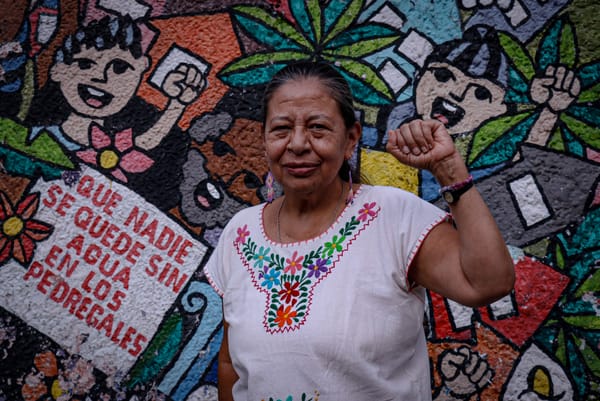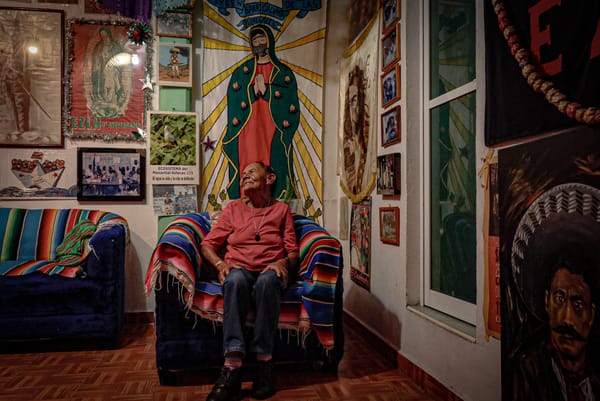Faces of Water: Water is most beautiful when falling
The neighbors of the Pedregal of Santo Domingo came together to protest a developer who drained a fresh spring into the sewers.

Without the stories of the yoke and the hands wounded from breaking up stones, it would be hard to understand why an entire neighborhood camped out for two years to denounce the “ecocide” committed by a real estate company at Avenida Aztecas 215, on one of the Pedregal of Santo Domingo’s main thoroughfares.
María Santiago Maqueda, an indigenous woman who, when interviewed, wears a colorful embroidered blouse and a hat to protect from the sun, was part of the protest. “How we fought for that aquifer that the company Quiero Casa hit, and the bad government we have! But they didn’t pay attention to the people’s demands. We had eight assemblies, marches and protests, and we sadly saw how much water they discarded down the drain. Now they’re worried about the water problem, now they talk about Aztecas 215. We know that its water comes from the Xitle volcano, the Dinamos, and reaches Iztapalapa. Now they are concerned, but at the time, they ignored our call.”
María Santiago was born in the state of Hidalgo and came to the Pedregal during the occupation, in late 1971: “I saw the lack of water, I saw the neighbors carrying their water with yokes, crossing those stones, because here in Santo Domingo was just rock formations. No one wanted to live here because it was just rocks. They said we looked like goats, jumping between rocks.”
The neighbors began organizing against Quiero Casa in 2015, when the city was governed by Miguel Ángel Mancera. The Coyoacán demarcation was in the hands of now-fugitive Mauricio Toledo, whose extradition for illicit enrichment Chile denied Mexico. Both were elected by the Party of the Democratic Revolution (PRD), then the party of the Mexican electoral left.
“Mancera told us that the water was dirty, and [secretary general] Patricia Mercado that it was dripping from the cracks, but Dr. Óscar Escolero from UNAM’s Institute of Geology demonstrated that it was clean, potable water, part of the same body of water up in Copete Park,” María recalls.
Facing the officials’ indifference, the people created a protest camp: they installed a tent in the street outside the door where construction workers entered and exited the site. There, the neighbors became the protagonists of the first movement to defend potable water in the Mexican megalopolis.
“This camp was maintained thanks to the solidarity of our brothers who donated us pots of coffee, beans, supplies. From there on, everyone saw how much water was being flushed into the drain. We said it was an ecocide, because water scarcity doesn’t just happen here, it’s all over the world. [Government officials] became accomplices to the company’s wasting water,” recounts María Santiago.
In each weekly assembly, the neighbors cut off traffic on Avenida Aztecas to invite other residents into the discussion. On Fridays, they hosted the Stone and Spring People’s School, which received people from all over the country and Latin America in solidarity with the Pedregal.
For Doña Fili, it was a unique educational space for the community.
“A protest camp transforms you. It transforms your thinking. Everything they’ve imposed on you to think changes. And that scares the system, the government, not just in Mexico, in the whole world, because people have the capacity to organize,” she insists. “Many people came to meet us, and all thanks to the spring. Not to brag, but long live the protest camp of Aztecas 215!”
Text: Flor Pagola, Caro Bas, Madeleine Wattenbarger and Eliana Gilet
Photo: Lizbeth Hernández
Design: Paola Macedo
This story is part of Faces of Water: Stories of Women Defending Water in Montevideo and Mexico City, a project by the Cooperativa de Periodismo and Kaja Negra, supported by the 2024 ColaborAccíon grant from the Fundación Gabo and Fundación Avina.



